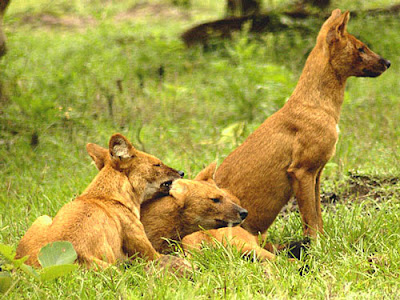Animal Unique | Dhole | Dhole, also known as the Asiatic wild dog or Indian wild dog, is a species of canid from South and Southeast Asia. It is the only existing member of the genus Cuon of Canis differs by the limited choice and higher number of teats. The dholes are classified as endangered by the IUCN, due to continuing habitat loss, depletion of prey base, competition from other predators, persecution and possible diseases from domestic and wild dogs. The dhole normally lives in forest habitats, but can also stretch a living in the open steppes of Kashmir and Siberia. Today, very little is known about the distribution of the dhole, but limited surveys indicate serious decline and fragmentation of the former range. The best remaining populations are likely to find in central and southern India, but even the stability is in question.
Scientific classification
Kingdom: Animalia
Phylum: Chordata
Class: Mammalia
Order: Carnivora
Family: Canidae
Subfamily: Caninae
Genus: Cuon, Hodgson, 1838
Species: C. alpinus
Kingdom: Animalia
Phylum: Chordata
Class: Mammalia
Order: Carnivora
Family: Canidae
Subfamily: Caninae
Genus: Cuon, Hodgson, 1838
Species: C. alpinus
The dhole has a broad skull and short, broad muzzle. The fur on the back and sides is reddish brown, while the neck, chest and underside are white or light colored. Dholes or Asian wild dogs are pack-living canids, although they are unique among this family in having a stocky snout and a lower molar tooth on both sides of the mandible. The bushy tail is black and the pups are also born a sooty black color before acquiring their adult coat around the age of three months. The large round ears are filled with white hair and the eyes are orange. Males are generally considerably larger than the females. Dholes have a wide range of sounds, including a very distinctive whistle that is used to get members back together in the dense forests with their habitat
The dhole is a very cooperative and social animals, living in organized packs of around 10 individuals. Groups often contain more men than women, usually with only one breeding female. Occasionally there are large groups of more than 40 dogs seen, possibly due to the temporary fusion of neighboring packs. Together with the gray wolf, African hunting dog and Amazonian bush dog, the dhole is one of the few dogs that regularly hunts in packs. This requires intelligence, coordination, and some courage! In India, one of the dhole's favorite prey is the medium-sized Axis deer. In some cases, however, will have to tackle larger prey like the banteng (a large Bovid), and very aggressive prey like the wild boar. With such dangerous quarry, the dogs can literally risk their lives to the food they need to survive secure. Communal hunting is especially important during the breeding season when pack members return to the cave to outbreaks of food for the mother and pups. Sometimes, however, dholes prefer to hunt individually or in pairs, with an emphasis on smaller prey such as hares.
Dholes produce whistle resembling the calls of red foxes, sometimes shown as "Coo-Coo". How this sound is produced is not known, but it is thought to help coordinate the pack when traveling through thick brush. Dholes have a complex body language. Sincerely submissive or be accompanied by horizontal lip retraction and reduction of the tail, but also licking. Playful dholes will open their mouth with their lips drawn back and their tails held in a vertical position, while based on a play bow. Aggressive or threatening dholes folds will continue their lips in a snarl and raise the hairs on their backs and hold their tails horizontally or vertically. When frightened, they withdraw their lips horizontally with the tail folded and their ears flat against the skull.
Dhole numbers have reduced their habitat is destroyed during a large part of the Asian continent, the human population explosion has led to the clearance of forests for timber and to make way for agriculture and development. Historically, hunters dholes seen the competition and thus persecuted them; premiums were offered for their fur. Today, habitat loss and the elimination of prey are the biggest threats to the survival of the dhole. Dholes are protected by the bulk of their range.India and Nepal, are protected in many dholes tiger reserves and this has helped to keep their stronghold in southern India
Animal Unique




